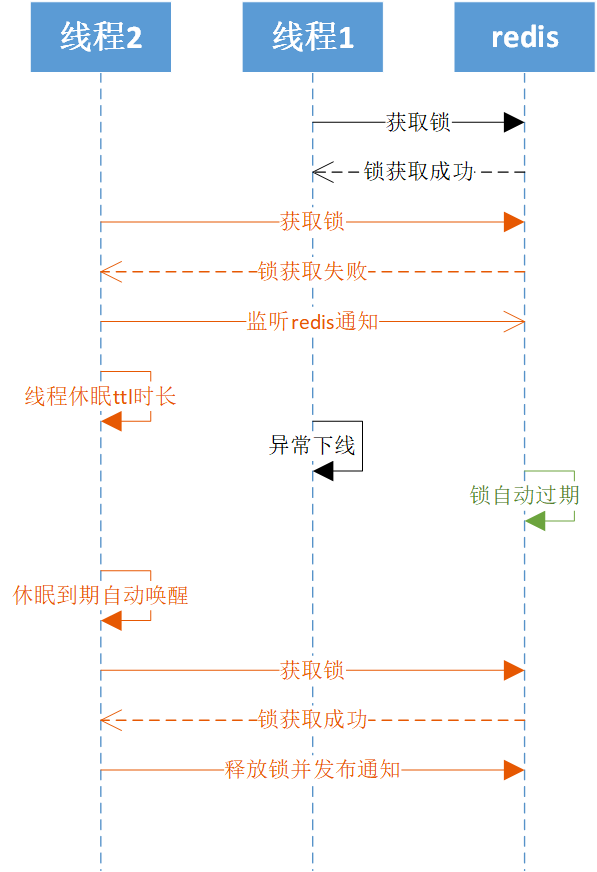

redis分布式锁RedissonLock的实现细节
source link: https://wakzz.cn/2020/04/21/java/redis%E5%88%86%E5%B8%83%E5%BC%8F%E9%94%81RedissonLock%E7%9A%84%E5%AE%9E%E7%8E%B0%E7%BB%86%E8%8A%82/
Go to the source link to view the article. You can view the picture content, updated content and better typesetting reading experience. If the link is broken, please click the button below to view the snapshot at that time.

redis分布式锁RedissonLock的实现细节
String key = "key-lock";
RLock lock = redisson.getLock(key);
lock.lock();
try {
// TODO
} catch (Exception e){
log.error(e.getMessage(), e);
} finally {
lock.unlock();
}
String key = "key-tryLock";
long maxWaitTime = 3_000;
RLock lock = redisson.getLock(key);
if (lock.tryLock(maxWaitTime, TimeUnit.MILLISECONDS)){
try {
// TODO
} catch (Exception e){
log.error(e.getMessage(), e);
} finally {
lock.unlock();
}
} else {
log.debug("redis锁竞争失败");
}
多个线程节点锁竞争的正常流程如下图:

多个线程节点锁竞争,并出现节点下线的异常流程如下图:

RedissonLock是可重入锁,使用redis的hash结构作为锁的标识存储,锁的名称作为hash的key,UUID + 线程ID作为hash的field,锁被重入的次数作为hash的value。如图所示:

private void lock(long leaseTime, TimeUnit unit, boolean interruptibly) throws InterruptedException {
long threadId = Thread.currentThread().getId();
// 尝试获取锁,锁获取成功则ttl为null;获取失败则返回锁的剩余过期时间
Long ttl = tryAcquire(leaseTime, unit, threadId);
if (ttl == null) {
return;
}
// 锁被其他线程占用而索取失败,使用线程通知而非自旋的方式等待锁
// 使用redis的发布订阅pub/sub功能来等待锁的释放通知
RFuture<RedissonLockEntry> future = subscribe(threadId);
commandExecutor.syncSubscription(future);
try {
while (true) {
ttl = tryAcquire(leaseTime, unit, threadId);
// 尝试获取锁,锁获取成功则ttl为null;获取失败则返回锁的剩余过期时间
if (ttl == null) {
break;
}
if (ttl >= 0) {
// 使用LockSupport.parkNanos方法线程休眠
try {
getEntry(threadId).getLatch().tryAcquire(ttl, TimeUnit.MILLISECONDS);
} catch (InterruptedException e) {
if (interruptibly) {
throw e;
}
getEntry(threadId).getLatch().tryAcquire(ttl, TimeUnit.MILLISECONDS);
}
} else {
if (interruptibly) {
getEntry(threadId).getLatch().acquire();
} else {
getEntry(threadId).getLatch().acquireUninterruptibly();
}
}
}
} finally {
// 退出锁竞争(锁获取成功或者放弃获取锁),则取消锁的释放订阅
unsubscribe(future, threadId);
}
}
public boolean tryLock(long waitTime, long leaseTime, TimeUnit unit) throws InterruptedException {
long time = unit.toMillis(waitTime);
long current = System.currentTimeMillis();
long threadId = Thread.currentThread().getId();
Long ttl = tryAcquire(leaseTime, unit, threadId);
if (ttl == null) {
return true;
}
time -= System.currentTimeMillis() - current;
if (time <= 0) {
acquireFailed(threadId);
return false;
}
current = System.currentTimeMillis();
RFuture<RedissonLockEntry> subscribeFuture = subscribe(threadId);
if (!await(subscribeFuture, time, TimeUnit.MILLISECONDS)) {
if (!subscribeFuture.cancel(false)) {
subscribeFuture.onComplete((res, e) -> {
if (e == null) {
unsubscribe(subscribeFuture, threadId);
}
});
}
acquireFailed(threadId);
return false;
}
try {
time -= System.currentTimeMillis() - current;
if (time <= 0) {
acquireFailed(threadId);
return false;
}
while (true) {
long currentTime = System.currentTimeMillis();
ttl = tryAcquire(leaseTime, unit, threadId);
// lock acquired
if (ttl == null) {
return true;
}
time -= System.currentTimeMillis() - currentTime;
if (time <= 0) {
acquireFailed(threadId);
return false;
}
currentTime = System.currentTimeMillis();
if (ttl >= 0 && ttl < time) {
getEntry(threadId).getLatch().tryAcquire(ttl, TimeUnit.MILLISECONDS);
} else {
getEntry(threadId).getLatch().tryAcquire(time, TimeUnit.MILLISECONDS);
}
time -= System.currentTimeMillis() - currentTime;
if (time <= 0) {
acquireFailed(threadId);
return false;
}
}
} finally {
unsubscribe(subscribeFuture, threadId);
}
}
RedissonLock实现的是可重入锁,通过redis的hash结构实现,而非加单的set nx ex。为了实现原子性的复杂的加锁逻辑,而通过lua脚本实现。获取锁会有如下三种状态:
- 锁未被任何线程占用,则锁获取成功,返回null
- 锁被当前线程占用,则锁获取成功并进行锁的重入,对锁的重入计数+1,返回null
- 锁被其他线程占用,则锁获取失败,返回该锁的自动过期时间ttl
<T> RFuture<T> tryLockInnerAsync(long leaseTime, TimeUnit unit, long threadId, RedisStrictCommand<T> command) {
internalLockLeaseTime = unit.toMillis(leaseTime);
return commandExecutor.evalWriteAsync(getName(), LongCodec.INSTANCE, command,
"if (redis.call('exists', KEYS[1]) == 0) then " +
"redis.call('hset', KEYS[1], ARGV[2], 1); " +
"redis.call('pexpire', KEYS[1], ARGV[1]); " +
"return nil; " +
"end; " +
"if (redis.call('hexists', KEYS[1], ARGV[2]) == 1) then " +
"redis.call('hincrby', KEYS[1], ARGV[2], 1); " +
"redis.call('pexpire', KEYS[1], ARGV[1]); " +
"return nil; " +
"end; " +
"return redis.call('pttl', KEYS[1]);",
Collections.<Object>singletonList(getName()), internalLockLeaseTime, getLockName(threadId));
}
当锁因为被其他线程占用而 使用redis的发布订阅pub/sub功能,通过监听锁的释放通知(在其他线程通过RedissonLock释放锁时,会通过发布订阅pub/sub功能发起通知),等待锁被其他线程释放。通过如此的线程唤醒而非自旋的操作,提高了锁的效率。
public RFuture<E> subscribe(String entryName, String channelName) {
AtomicReference<Runnable> listenerHolder = new AtomicReference<Runnable>();
AsyncSemaphore semaphore = service.getSemaphore(new ChannelName(channelName));
RPromise<E> newPromise = new RedissonPromise<E>() {
@Override
public boolean cancel(boolean mayInterruptIfRunning) {
return semaphore.remove(listenerHolder.get());
}
};
Runnable listener = new Runnable() {
@Override
public void run() {
E entry = entries.get(entryName);
if (entry != null) {
entry.aquire();
semaphore.release();
entry.getPromise().onComplete(new TransferListener<E>(newPromise));
return;
}
E value = createEntry(newPromise);
value.aquire();
E oldValue = entries.putIfAbsent(entryName, value);
if (oldValue != null) {
oldValue.aquire();
semaphore.release();
oldValue.getPromise().onComplete(new TransferListener<E>(newPromise));
return;
}
RedisPubSubListener<Object> listener = createListener(channelName, value);
service.subscribe(LongCodec.INSTANCE, channelName, semaphore, listener);
}
};
semaphore.acquire(listener);
listenerHolder.set(listener);
return newPromise;
}
由于是可重入锁则需要在释放锁的时候做订阅通知,因此释放锁的操作同样是lua脚本实现。锁的释放会有如下三个状态:
- 等待释放的锁不存在或者不是当前线程持有,返回null
- 等待释放的锁被当前线程持有,且该锁当前被重入多次,则锁的重入计数-1,返回0
- 等待释放的锁被当前线程持有,且该锁当前未被重入,则锁的删除并发布该锁释放的订阅通知,返回1
protected RFuture<Boolean> unlockInnerAsync(long threadId) {
return commandExecutor.evalWriteAsync(getName(), LongCodec.INSTANCE, RedisCommands.EVAL_BOOLEAN,
"if (redis.call('hexists', KEYS[1], ARGV[3]) == 0) then " +
"return nil;" +
"end; " +
"local counter = redis.call('hincrby', KEYS[1], ARGV[3], -1); " +
"if (counter > 0) then " +
"redis.call('pexpire', KEYS[1], ARGV[2]); " +
"return 0; " +
"else " +
"redis.call('del', KEYS[1]); " +
"redis.call('publish', KEYS[2], ARGV[1]); " +
"return 1; "+
"end; " +
"return nil;",
Arrays.<Object>asList(getName(), getChannelName()), LockPubSub.UNLOCK_MESSAGE, internalLockLeaseTime, getLockName(threadId));
}
Watchdog
RedissonLock为了避免应用获取锁后宕机,因为没人来释放锁而导致死锁情况的出现,默认每次锁的占用只有30秒的时间(org.redisson.config.Config#lockWatchdogTimeout = 30 * 1000)。于是便有了Watchdog设计,由独立的线程定时给未释放的锁续期,默认锁有效期的三分之一的时长即每10秒给锁自动续期。
private void renewExpiration() {
ExpirationEntry ee = EXPIRATION_RENEWAL_MAP.get(getEntryName());
if (ee == null) {
return;
}
// 默认10秒钟后执行锁续期任务
Timeout task = commandExecutor.getConnectionManager().newTimeout(new TimerTask() {
@Override
public void run(Timeout timeout) throws Exception {
ExpirationEntry ent = EXPIRATION_RENEWAL_MAP.get(getEntryName());
if (ent == null) {
return;
}
Long threadId = ent.getFirstThreadId();
if (threadId == null) {
return;
}
RFuture<Boolean> future = renewExpirationAsync(threadId);
future.onComplete((res, e) -> {
if (e != null) {
log.error("Can't update lock " + getName() + " expiration", e);
return;
}
// 如果锁续期成功,则10秒钟后再次续期
if (res) {
renewExpiration();
}
});
}
}, internalLockLeaseTime / 3, TimeUnit.MILLISECONDS);
ee.setTimeout(task);
}
protected RFuture<Boolean> renewExpirationAsync(long threadId) {
return commandExecutor.evalWriteAsync(getName(), LongCodec.INSTANCE, RedisCommands.EVAL_BOOLEAN,
"if (redis.call('hexists', KEYS[1], ARGV[2]) == 1) then " +
"redis.call('pexpire', KEYS[1], ARGV[1]); " +
"return 1; " +
"end; " +
"return 0;",
Collections.<Object>singletonList(getName()),
internalLockLeaseTime, getLockName(threadId));
}
Recommend
About Joyk
Aggregate valuable and interesting links.
Joyk means Joy of geeK